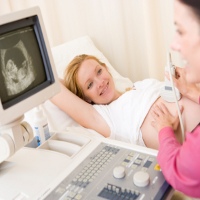Jakarta Indonesian, sometimes the fetus showed a certain facial expression when she carried ultrasound (sonography) was investigated. But it turns out that given the fetal expression could be an indicator of brain function.
The study, led by British researcher Dr. Nadia Reifiland, said that the developed expression, as we will laugh and cry before birth and become more complex, until you reach 36 weeks of pregnancy.
The development of facial expression in the fetus is important to know the different functions after birth, required as a child sucks when eating, jaw and tongue to talk and needed to improve the adhesion of children and parents after the birth.
Facial muscles began to grow after 8 weeks of pregnancy, and uses all the muscles of facial expression formed by the age of 16 weeks. Possibility of facial expressions in fetuses 24-36 weeks of fatty tissue that has built at this time.
Researchers who study facial expressions through the use of fetal Facial Action Coding System (FACS) on a 4-D ultrasound. With increasing duration of pregnancy, then the movement of the face, limbs and body of the fetus is growing with the structural development of the central nervous system correlates.
These developments suggest a link between fetal cerebral cortex and peripheral structures are functional. Therefore, the expression of the fetal brain may be able to predict the function of a healthy fetus.
"The results of this study show that there is great potential for this method to evaluate the development of the fetus," said Dr. Nadja Reifiland of Durham University, as quoted Medindi, Saturday (09/24/2011).
Dr. Reifiland the code analysis and enables researchers to objectively track the increase in complexity over time to produce a recognizable facial expressions.
Encoding method of the fetal facial expression is useful for:
1st Marker for normal development to determine
2nd He has a great potential to evaluate the integrity of the central nervous system of fetuses
3rd For detection of functional or structural disorders of the brain
4th To recognize the distinction between the development of normal and abnormal fetal face health problems in the uterus.
The study, led by British researcher Dr. Nadia Reifiland, said that the developed expression, as we will laugh and cry before birth and become more complex, until you reach 36 weeks of pregnancy.
The development of facial expression in the fetus is important to know the different functions after birth, required as a child sucks when eating, jaw and tongue to talk and needed to improve the adhesion of children and parents after the birth.
Facial muscles began to grow after 8 weeks of pregnancy, and uses all the muscles of facial expression formed by the age of 16 weeks. Possibility of facial expressions in fetuses 24-36 weeks of fatty tissue that has built at this time.
Researchers who study facial expressions through the use of fetal Facial Action Coding System (FACS) on a 4-D ultrasound. With increasing duration of pregnancy, then the movement of the face, limbs and body of the fetus is growing with the structural development of the central nervous system correlates.
These developments suggest a link between fetal cerebral cortex and peripheral structures are functional. Therefore, the expression of the fetal brain may be able to predict the function of a healthy fetus.
"The results of this study show that there is great potential for this method to evaluate the development of the fetus," said Dr. Nadja Reifiland of Durham University, as quoted Medindi, Saturday (09/24/2011).
Dr. Reifiland the code analysis and enables researchers to objectively track the increase in complexity over time to produce a recognizable facial expressions.
Encoding method of the fetal facial expression is useful for:
1st Marker for normal development to determine
2nd He has a great potential to evaluate the integrity of the central nervous system of fetuses
3rd For detection of functional or structural disorders of the brain
4th To recognize the distinction between the development of normal and abnormal fetal face health problems in the uterus.



0 comments:
Post a Comment